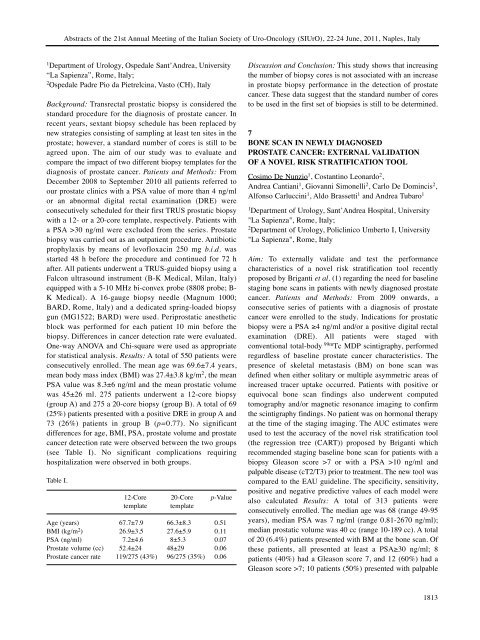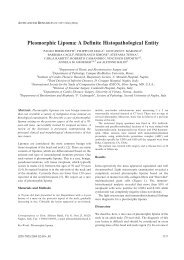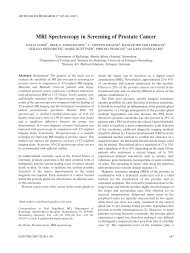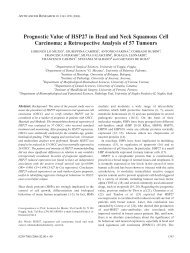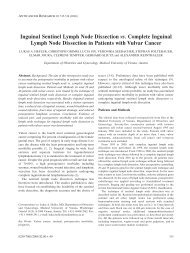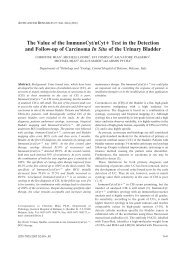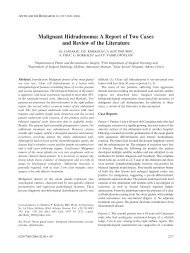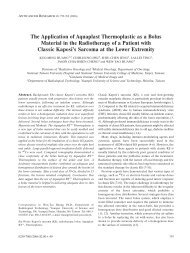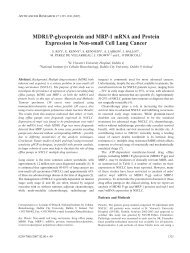ABSTRACTS OF THE 21st ANNUAL MEETING OF THE ITALIAN ...
ABSTRACTS OF THE 21st ANNUAL MEETING OF THE ITALIAN ...
ABSTRACTS OF THE 21st ANNUAL MEETING OF THE ITALIAN ...
Create successful ePaper yourself
Turn your PDF publications into a flip-book with our unique Google optimized e-Paper software.
1Department of Urology, Ospedale Sant’Andrea, University<br />
“La Sapienza”, Rome, Italy;<br />
2Ospedale Padre Pio da Pietrelcina, Vasto (CH), Italy<br />
Background: Transrectal prostatic biopsy is considered the<br />
standard procedure for the diagnosis of prostate cancer. In<br />
recent years, sextant biopsy schedule has been replaced by<br />
new strategies consisting of sampling at least ten sites in the<br />
prostate; however, a standard number of cores is still to be<br />
agreed upon. The aim of our study was to evaluate and<br />
compare the impact of two different biopsy templates for the<br />
diagnosis of prostate cancer. Patients and Methods: From<br />
December 2008 to September 2010 all patients referred to<br />
our prostate clinics with a PSA value of more than 4 ng/ml<br />
or an abnormal digital rectal examination (DRE) were<br />
consecutively scheduled for their first TRUS prostatic biopsy<br />
with a 12- or a 20-core template, respectively. Patients with<br />
a PSA >30 ng/ml were excluded from the series. Prostate<br />
biopsy was carried out as an outpatient procedure. Antibiotic<br />
prophylaxis by means of levofloxacin 250 mg b.i.d. was<br />
started 48 h before the procedure and continued for 72 h<br />
after. All patients underwent a TRUS-guided biopsy using a<br />
Falcon ultrasound instrument (B-K Medical, Milan, Italy)<br />
equipped with a 5-10 MHz bi-convex probe (8808 probe; B-<br />
K Medical). A 16-gauge biopsy needle (Magnum 1000;<br />
BARD, Rome, Italy) and a dedicated spring-loaded biopsy<br />
gun (MG1522; BARD) were used. Periprostatic anesthetic<br />
block was performed for each patient 10 min before the<br />
biopsy. Differences in cancer detection rate were evaluated.<br />
One-way ANOVA and Chi-square were used as appropriate<br />
for statistical analysis. Results: A total of 550 patients were<br />
consecutively enrolled. The mean age was 69.6±7.4 years,<br />
mean body mass index (BMI) was 27.4±3.8 kg/m 2 , the mean<br />
PSA value was 8.3±6 ng/ml and the mean prostatic volume<br />
was 45±26 ml. 275 patients underwent a 12-core biopsy<br />
(group A) and 275 a 20-core biopsy (group B). A total of 69<br />
(25%) patients presented with a positive DRE in group A and<br />
73 (26%) patients in group B (p=0.77). No significant<br />
differences for age, BMI, PSA, prostate volume and prostate<br />
cancer detection rate were observed between the two groups<br />
(see Table I). No significant complications requiring<br />
hospitalization were observed in both groups.<br />
Table I.<br />
Abstracts of the <strong>21st</strong> Annual Meeting of the Italian Society of Uro-Oncology (SIUrO), 22-24 June, 2011, Naples, Italy<br />
12-Core 20-Core p-Value<br />
template template<br />
Age (years) 67.7±7.9 66.3±8.3 0.51<br />
BMI (kg/m 2 ) 26.9±3.5 27.6±5.9 0.11<br />
PSA (ng/ml) 7.2±4.6 8±5.3 0.07<br />
Prostate volume (cc) 52.4±24 48±29 0.06<br />
Prostate cancer rate 119/275 (43%) 96/275 (35%) 0.06<br />
Discussion and Conclusion: This study shows that increasing<br />
the number of biopsy cores is not associated with an increase<br />
in prostate biopsy performance in the detection of prostate<br />
cancer. These data suggest that the standard number of cores<br />
to be used in the first set of biopsies is still to be determined.<br />
7<br />
BONE SCAN IN NEWLY DIAGNOSED<br />
PROSTATE CANCER: EXTERNAL VALIDATION<br />
<strong>OF</strong> A NOVEL RISK STRATIFICATION TOOL<br />
Cosimo De Nunzio1 , Costantino Leonardo2 ,<br />
Andrea Cantiani1 , Giovanni Simonelli2 , Carlo De Domincis2 ,<br />
Alfonso Carluccini1 , Aldo Brassetti1 and Andrea Tubaro1 1Department of Urology, Sant’Andrea Hospital, University<br />
"La Sapienza", Rome, Italy;<br />
2Department of Urology, Policlinico Umberto I, University<br />
"La Sapienza", Rome, Italy<br />
Aim: To externally validate and test the performance<br />
characteristics of a novel risk stratification tool recently<br />
proposed by Briganti et al. (1) regarding the need for baseline<br />
staging bone scans in patients with newly diagnosed prostate<br />
cancer. Patients and Methods: From 2009 onwards, a<br />
consecutive series of patients with a diagnosis of prostate<br />
cancer were enrolled to the study. Indications for prostatic<br />
biopsy were a PSA ≥4 ng/ml and/or a positive digital rectal<br />
examination (DRE). All patients were staged with<br />
conventional total-body 99m Tc MDP scintigraphy, performed<br />
regardless of baseline prostate cancer characteristics. The<br />
presence of skeletal metastasis (BM) on bone scan was<br />
defined when either solitary or multiple asymmetric areas of<br />
increased tracer uptake occurred. Patients with positive or<br />
equivocal bone scan findings also underwent computed<br />
tomography and/or magnetic resonance imaging to confirm<br />
the scintigraphy findings. No patient was on hormonal therapy<br />
at the time of the staging imaging. The AUC estimates were<br />
used to test the accuracy of the novel risk stratification tool<br />
(the regression tree (CART)) proposed by Briganti which<br />
recommended staging baseline bone scan for patients with a<br />
biopsy Gleason score >7 or with a PSA >10 ng/ml and<br />
palpable disease (cT2/T3) prior to treatment. The new tool was<br />
compared to the EAU guideline. The specificity, sensitivity,<br />
positive and negative predictive values of each model were<br />
also calculated Results: A total of 313 patients were<br />
consecutively enrolled. The median age was 68 (range 49-95<br />
years), median PSA was 7 ng/ml (range 0.81-2670 ng/ml);<br />
median prostatic volume was 40 cc (range 10-189 cc). A total<br />
of 20 (6.4%) patients presented with BM at the bone scan. Of<br />
these patients, all presented at least a PSA≥30 ng/ml; 8<br />
patients (40%) had a Gleason score 7, and 12 (60%) had a<br />
Gleason score >7; 10 patients (50%) presented with palpable<br />
1813


